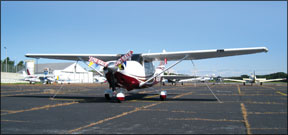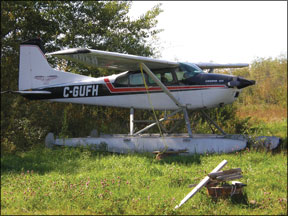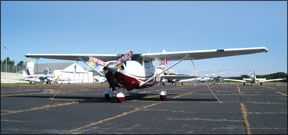In 2003 when we looked at the aircraft loan market we said, “If rates go much lower, the money will be free.” Well, theyre lower. And though the money isn’t free yet, its cheap to those who can qualify. The recent financial chaos means there’s no wink-wink, nudge-nudge approval, but it also means that the surviving lenders are looking for those qualified buyers. There’s less competition in the loan market and some big players, like Sovereign Bank, have pulled out. Reselling and securitization of loans isn’t the market it once was. This means a greater reliance on equity lending-borrowing against the value of the aircraft-and tougher standards for the borrower. 
Your Credit Picture
As weve said before, evaluating your own credit is a good idea. Stats say up to three out of four personal credit reports contain some error. It may take up to two months for you to clear erroneous information. Get that process rolling right away. Privacy Guard is a reseller of credit information weve looked at in the past. There’s also the well-known Equifax.
These services offer reports, as we’ll as ongoing monitoring that will alert you if something pops up during the time youre shopping around for a loan. This is important because weve heard from lenders that banks are getting extra touchy about things like outstanding credit card debt or missed payments. Where one erroneous late payment wouldnt have tanked a deal in the past, it can now. Lenders are looking for credit scores of 700 or so these days, about 50 points higher than when we looked at this topic two years ago.
In addition to getting that squared away, expect to deliver two years of tax returns, proof of income and your personal financial statement. Cathy Nyen of Cirrus Finance told us that liquidity is particularly under the microscope. Banks want to ensure an buyer can withstand an unexpected drop in income. Take a look at your debt-to-income ratio (DTI). This is essentially all your monthly payments (including the aircraft loan) divided into your monthly income. Lenders are accepting DTIs of up to 50 percent, a bit higher than in recent years.
If youre weak somewhere on the triumvirate of credit-score/liquidity/DTI, don’t panic. Its a package deal. That said, weve heard rejection rates as high as 60 to 70 percent of applicants contacting lenders. That may reflect a number of people rolling the dice in a vain attempt to stem the outflow from overleveraged aircraft. Nyen of Cirrus says the rejection number is we’ll under 25 percent from where she sits. Dan Garelloni, president of Mile High Financial, says he sees numbers more like Nyens.
All lenders agree that getting your credit squared away early, even before you have specific aircraft in mind, is a good plan.
Newer Aircraft Easier
Where 20-year terms and 10 percent down was common even two years ago, the majority of lenders we spoke to require 15 percent. Thats 15 percent of the valuation or the agreed purchase price, whichever is lower. Many want 20 percent for new aircraft where just the first year depreciation can put a borrower underwater. Lenders still sting from many repos sold at auction. AOPA has good

online aircraft valuation tool.
For the same reason, many lenders are shying away from older aircraft. “Old” for a piston plane is pre-1975. For turboprops, they want to see 1980, and for jets its 1990 at the oldest. Some lenders wont do jets even 10 years old. The model also matters. For the same year, its harder to get financing on a Cirrus SR22 than a Bonanza because there’s still a glut of the former on the market. Eclipse 500s are tough because the companys future is uncertain even though its under new management. This makes the lender nervous in the face of your possible default and their acquisition of the aircraft. Other safe bets we heard lenders like are 172s, Meridians, King Airs and small- to mid-size Citations.
Before you give up on that beautifully preserved and updated 1968 Comanche, however, realize that the aircraft lending market is a niche by definition and lenders are stratifying to find their sub-niche within it. Mike Jacobs is the former president of First Pryority, a lender in the aircraft market for many years, and says they like older, single-engine pistons for the very reason that other lenders don’t. First Pryority is a direct lender, so they don’t have to convince another bank to get the money. That said, Jacobs acknowledged its an increased risk that results in a higher interest rate. Where a three-year-old Cessna might garner a 5.75-percent loan, a similar loan on the 68 Comanche could top seven percent. You need to weigh this out on what it means for the total cost to you of the aircraft.
Many lenders will offer loans against avionics upgrades and there are those who will underwrite experiementals. New light sport designs arent quite so lucky. Some banks will loan for established manufacturers such as Flight Design, Remos, Evektor and Tecnam, as we’ll as known companies like Cessna and Vans Aircraft for the LSA homebuilt RV-12. Getting a loan north of $100,000 for a lesser known manufacturer is almost impossible.
Each bank may have its own quirks. Many wont write an aircraft that has had any damage history. Some want detailed photos of installed equipment. Apparently there was a rash of avionics disappearing out of aircraft just before repossession in recent years.
Picking a Loan
The questions you need to ask are: What can I afford each month and how long will I be in the airplane?
Youll hear different rates for the three basic types of loans: fixed, variable and balloon. Fixed-rate loans give you the same interest rate that stays fixed for the life of the loan. These protect you and that great rate youre locking in, but cost more as interest rates will likely go up (they cant go much further down). The longer the loan term, the more risk the bank is taking. Were not seeing much difference in 15-year versus 20-year fixed rates, but there are buyers getting astounding rates on five- to seven-year fixed loans.
Variable-rate loans adjust to an agreed index, such as the prime rate. Youll get a better rate on these loans short-term but the rate can, and probably will, rise. Lenders we spoke to were split on the value of these to the buyer. Given the sluggishness of the economy, many agree rates are unlikely to rise much in the next five years. If youre planning to be out of the airplane then, this could pay off for you. But that assumes you can sell the craft when the time comes.
Balloon loans guarantee a fixed rate for a pre-determined period of time, often five to seven years, based on amortization over a longer term, such as 15 years. This makes for low payments up front, but when the short term is up, the balance must be paid off or the loan converted with a rate increased to a stipulated amount for the rest of the loan term.
Most small aircraft buyers seem to be happy with the fixed rates given the protection it gives them down the line, and we think this is a good plan, especially if you can pay extra each month to pay down the principle faster.
Aircraft loans usually last less than five years. After that, the aircraft is sold or refinanced. We couldnt get hard data, but our hunch is this number is increasing, if for no other reason than the sales market is so soft. Another strategy if you have the cash is a bigger down payment. Paying 25 percent down can net you 0.1-0.2 percent off your rate, and could save $50 a month on a $300,000 loan. Think of it as getting your XM weather for free for the next 15 years.
Tom Bell of Excel Aircraft loans pointed out that this can be a great time to refinance for the right owner. The ideal candidate is someone who has some equity in the plane, or might be slightly upside-down on a newer aircraft but has some cash looking for an investment. The former could just refinance for a significantly lower rate and/or a shorter term. The latter would essentially invest in their own airplane and buy down the amount needed for the refinance. Either solution could slash the cumulative interest payment and work out as a net return on investment.
Refinancing a three- or four-year-old Cirrus bought at 6.5 percent could save hundreds of dollars a month. Refinancing a $2.7M jet under such terms could save hundreds of dollars a day.
We didnt see a major difference in rates from a broker versus working directly with a bank. They will perform the same services. You just want to watch that there’s no hidden fee from the broker for their services. Usually their fee is wrapped in the rate quoted on the loan. Any large fees you pay should come back to you in a lower rate or you should get your money elsewhere.
Closing costs are commonly around $600 for aircraft loans. Make sure there is no early payment penalty if you plan to save some interest by paying down the principal ahead of schedule.
Start Online
Any player now has a website where you can download loan applications and many have loan calculators to run some numbers on your own. Approvals are often made the same day, whether from banks or brokers.
Shop around. We like the idea of personal service smaller banks and brokers, as when Dan Garelloni told us, “Sometimes I really have to fight for these guys.” But were not seeing an advantage price wise in big versus small lenders.
There’s a hunger in lenders for good buyers. Just like it being a buyers market for aircraft, its a borrowers market for money if your personal finances are up to the scrutiny of a recently burned lending market.





